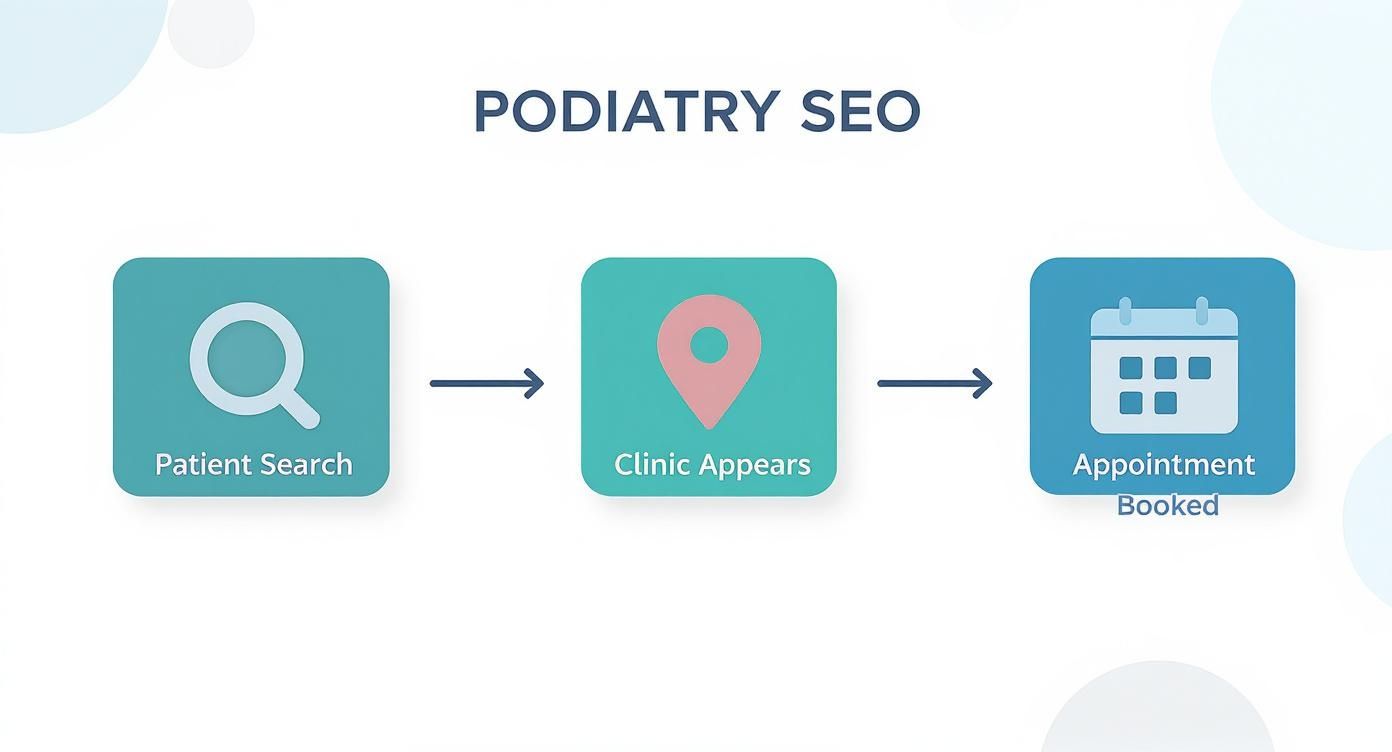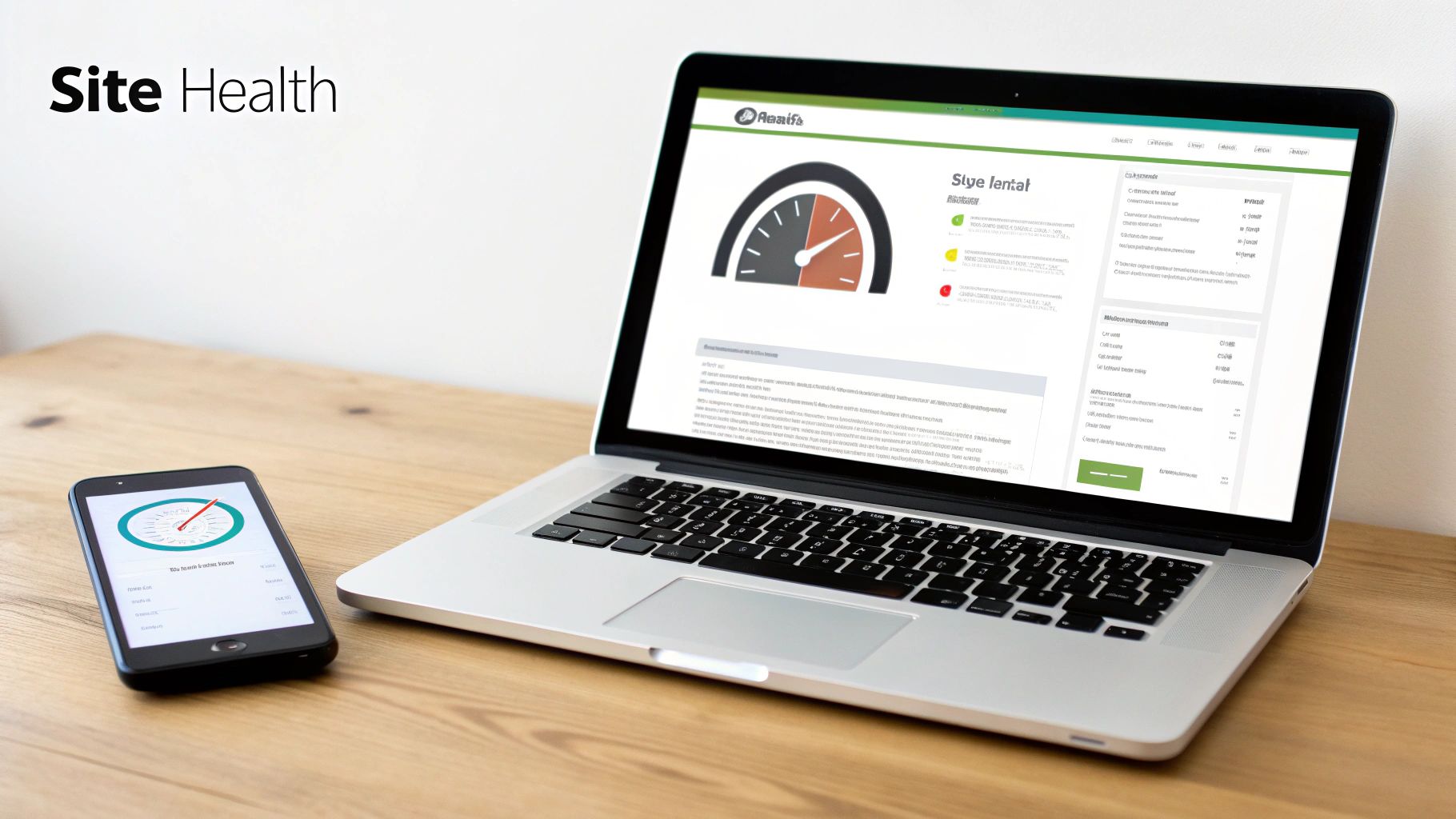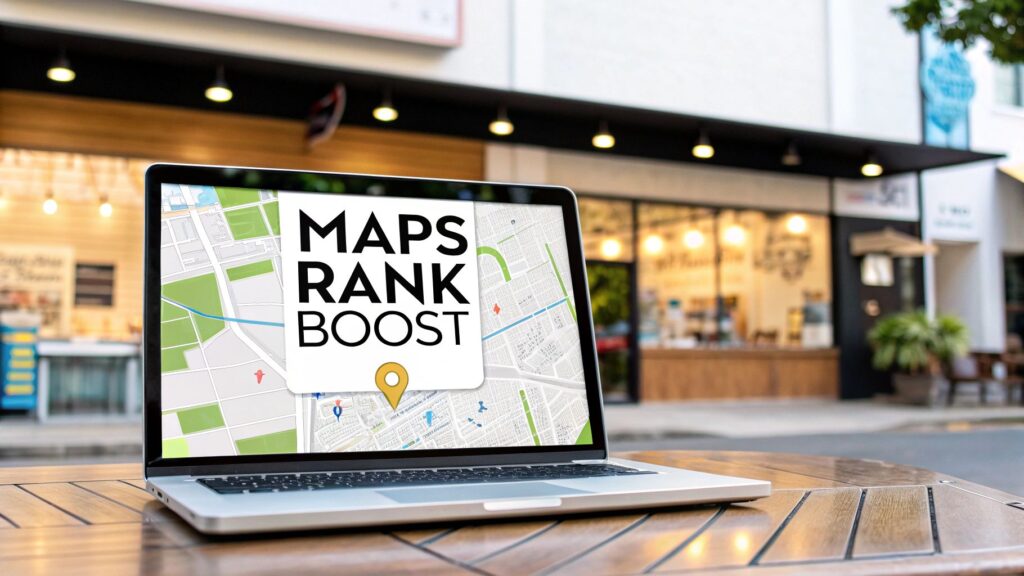Podiatry SEO is the process of making your clinic’s website more visible when local patients search on Google. Think of it as placing your practice on the busiest digital street corner in your city.
When someone in your area searches for "bunion treatment near me" or "best podiatrist in [Your City]," a smart SEO strategy helps your clinic show up at the top of the search results.
In Short: SEO helps patients who need a podiatrist find your clinic online.
Why is SEO important for a podiatrist?
Running a practice is a full-time job. Adding "SEO" to your list might seem overwhelming. But it’s one of the best ways to reach local patients who are actively looking for your services.
The days of relying on the Yellow Pages are over. Today, a patient's first step is searching on their phone. A strong podiatry SEO strategy ensures your clinic is the answer they find.
Connect with Patients Ready to Book an Appointment
Traditional ads cast a wide net. SEO is different. It targets patients who are already searching for solutions to their foot and ankle pain.
These aren't just casual browsers. They are motivated people who need help now. This means your marketing efforts connect you directly with individuals who are likely to schedule a visit.
Build a Lasting Source of New Patients
Paid ads provide a quick boost, but the leads stop when you stop paying. SEO builds a long-term asset for your practice.
In short: SEO is a sustainable patient-attraction machine that works for you 24/7. It's an investment that delivers a predictable stream of new patients without a constant ad budget.
Consistent online visibility also builds trust and authority. You can expand your digital footprint by using smart social media SEO strategies to amplify your clinic's reach even further.
Frequently Asked Questions About Podiatry SEO
If you're new to this, you probably have some questions. Here are a few common ones we hear from practice owners.
- How long does SEO take to work? SEO is a marathon, not a sprint. You may see some initial results in 3–4 months. However, significant, practice-changing results often take 6–12 months to achieve.
- Can I do SEO myself? Yes, you can. Many basic local SEO tasks can be managed in-house. However, working with a specialist can speed up the process and handle the more technical aspects.
- Is SEO better than paid ads? They are different tools for different goals and work best together. Ads offer immediate visibility, while SEO builds your long-term organic presence. A balanced strategy often uses both.
Winning at Local Search
For any podiatry clinic, local search is where the action is. When a potential patient types "podiatrist near me" or "heel pain treatment in [Your City]," you need to be the first name they see.
The main goal is to appear in the Google Map Pack. This is the box with three local businesses at the top of the search results. It’s where most patients make their decision.
Your Google Business Profile is Your Digital Front Door
Think of your Google Business Profile (GBP) as your digital storefront. It's often the first impression a potential patient has of your clinic.
A complete GBP is more than just a pin on a map. It's a dynamic profile where you can showcase your expertise, build trust, and provide the information patients need to choose you.
Don't just list your name and address. Fill out every section to send strong signals to Google that you are an active and relevant choice for local searches.
Google Business Profile Optimization Checklist
Use this checklist to optimize your podiatry clinic's Google Business Profile and attract local patients.
| Optimization Area | Action Item | Why It Matters for Patients |
|---|---|---|
| Clinic Information | Verify your Name, Address, and Phone number (NAP) are 100% accurate. | They need to know who you are, where you are, and how to reach you without any confusion. |
| Business Categories | Set "Podiatrist" as primary. Add secondary categories like "Foot Care," "Sports Medicine Clinic," etc. | This helps them find you for specific problems, not just general searches. |
| Services Menu | List every service you offer, from "Bunion Surgery" and "Custom Orthotics" to "Diabetic Foot Care." | Patients can quickly see if you provide the exact treatment they're looking for. |
| Photos & Videos | Upload high-quality images of your office (inside & out), staff, and equipment. | This builds trust and helps them feel comfortable with your clinic before they even visit. |
| Google Q&A | Proactively add and answer common questions (e.g., "Do you accept new patients?"). | It provides immediate answers and shows you're engaged and helpful. |
| Google Posts | Regularly share updates, health tips, or special announcements. | Keeps your profile fresh and shows your practice is active and current. |
An optimized profile doesn't just look good—it actively works to bring new patients to your door.
Choose the Right Categories and Services
This small detail has a big impact. Your primary category should be "Podiatrist," but secondary categories help you show up for more specific searches.
Think like a patient. Add categories like "Medical Clinic" or "Sports Medicine Clinic" if they fit your practice. Clinics using three to four relevant secondary categories often rank higher in local map results.
This journey—from a patient's search to a booked appointment—is fueled by a strong local presence.

A well-tuned profile doesn't just get seen; it gets patients to pick up the phone.
The Power of Citations and a Consistent NAP
Google cross-references your clinic's information across online directories like Yelp, Healthgrades, and Vitals. Each listing is called a citation.
The most important rule is NAP consistency. Your Name, Address, and Phone number must be identical everywhere.
- Good: 123 Foot Health Ave., Suite 101
- Bad: 123 Foot Health Avenue, #101
Even small differences can confuse search engines. To learn more, this practical guide to local SEO for small businesses is a great starting point.
Why Patient Reviews Are SEO Gold
Reviews are the lifeblood of local podiatry SEO. They provide powerful social proof that helps new patients feel confident choosing you.
Google’s algorithm also pays attention. It considers the quantity, quality, and recency of your reviews when ranking businesses in the Map Pack.
Here’s a simple plan for building a five-star reputation:
- Just ask. Encourage happy patients to share their experience online at the end of an appointment.
- Make it easy. Send a follow-up email or text with a direct link to your Google review page.
- Respond to every review. Thank people for positive feedback and address negative comments with professionalism.
Putting effort into these local SEO tasks will dramatically increase your visibility where it matters most.
Finding Keywords That Patients Actually Use
Keyword research is the foundation of a good podiatry SEO strategy. The goal is to find the exact words and phrases people use when they need help.
A person searching "podiatrist" is browsing. Someone typing "affordable bunion surgery in Miami" is ready to book an appointment. You need to find those high-intent phrases.
How to Brainstorm Keywords Like a Patient
Put yourself in your patients' shoes. The best keywords come from thinking about the problems you solve every day.
Group ideas into three main buckets:
- Condition-Based: Think about the ailments people see you for, like "plantar fasciitis treatment," "ingrown toenail relief," or "hammertoe correction."
- Treatment-Based: Focus on the solutions you offer, such as "custom orthotics near me," "shockwave therapy for foot pain," or "diabetic foot care."
- Question-Based: People ask Google direct questions. Brainstorm things like "why does my big toe hurt?" or "what causes heel pain in the morning?"
This exercise gives you a solid list of keywords that reflect what your potential patients care about.
In Short: Your keyword strategy should be built around the real conditions you treat, the specific services you provide, and the direct questions patients are asking online.
Discover Hidden Gem Keywords
Once you have a brainstormed list, it's time to expand it. You can use Google for free.
Type one of your keywords into the search bar and look at the "People Also Ask" box. These are actual questions people have searched for, making them perfect for blog posts or an FAQ page.
For example, a search for "plantar fasciitis" might show:
- How can I permanently cure plantar fasciitis?
- What is the fastest way to cure plantar fasciitis?
- What happens if plantar fasciitis is left untreated?
Answering these questions on your site positions you as an expert and builds trust.
Give Every Keyword a Home on Your Website
Next, organize your keywords by assigning them to specific pages. This is called keyword mapping. It tells Google what each page is about.
A simple map might look like this:
- Homepage: Use broad, location-based terms like "podiatrist in [Your City]" or "foot doctor near me."
- Service Pages: Get specific. A page on custom orthotics should target "custom orthotics" and "arch supports." A bunion surgery page should target "bunion surgery."
- Blog: This is the perfect place for question-based keywords. A post titled "5 Common Causes of Morning Heel Pain" can directly target the search "why does my heel hurt in the morning?"
Mapping out keywords brings a clear logic to your website and helps your podiatry SEO perform better.
Creating Content That Connects with Patients
Great content is the engine behind a successful podiatry SEO strategy. It’s your chance to build trust and answer patient questions before they ever visit your clinic.
When you create content that speaks to a patient's concerns, you start a relationship. It's a digital conversation that shows them you understand their problem.

Build Out Your Core Service Pages
Your service pages are the foundation of your website. Each page should be a deep, easy-to-read guide on a specific condition or service.
Think from a patient's perspective. Someone worried about bunion pain wants to know:
- What are the common symptoms of bunions?
- What makes them worse?
- Are there non-surgical options available?
- When is surgery necessary?
Your pages for plantar fasciitis, ingrown toenails, or diabetic foot care should answer these types of questions clearly. Use simple language and avoid medical jargon.
Key Takeaway: A great service page makes a patient feel informed. It should walk them through their condition and build their confidence in your practice.
Why Your Clinic Needs a Blog
Your service pages cover the "what" you do. Your blog answers the "why" and "how." A blog is a powerful tool in your podiatry SEO toolbox.
Use your blog to share patient success stories, explain new treatment technology, or offer seasonal advice like "summer foot care tips." A blog lets you target longer, more specific search terms like "best running shoes for flat feet."
Each blog post is a new opportunity to show up on Google and prove your expertise. It positions you as a trusted community resource.
Answering Real Questions Patients Are Asking
To make your content effective, you need to know what people are searching for. Here are a few real-world examples that could become your next blog post.
- How do you treat plantar fasciitis at home? This is a perfect blog topic. You can offer safe, practical advice while explaining when professional help is needed.
- What is the recovery time for bunion surgery? Answering this on your bunion service page is valuable and helps manage patient expectations.
- Are custom orthotics worth the money? This question deserves a detailed article explaining the benefits of custom orthotics compared to generic inserts.
When you create content that directly answers these questions, you become the local expert in the eyes of both Google and your future patients.
Using AI as Your Brainstorming Assistant
Let's be clear: AI should never write your medical content. Your expertise and empathy are irreplaceable. However, AI tools can be fantastic assistants for brainstorming topics and creating outlines.
Think of an AI tool as a research partner. You can ask it to generate a list of common questions about diabetic foot care or create an outline for a blog post on "5 Stretches to Relieve Heel Pain." This saves you time on planning.
By 2025, AI-powered SEO tools are helping podiatrists analyze data to find the keywords and topics that matter most. Marketing firms serving over 8% of American podiatry practices already use AI to shape their content strategies. You can learn more by reading the full profile on Podiatry Management.
The goal is to work smarter. Blending your medical knowledge with efficient workflows helps you build a library of resources that search engines and patients will love.
Getting the Technical SEO Right for Your Website
"Technical SEO" might sound complex, but the basics are manageable. Think of your website as your digital office. Technical SEO ensures the foundation is solid and the signs are clear.
A technically sound site also provides a better experience for patients. If your site is slow or broken on a phone, they will leave. Let’s break down what really matters for your podiatry SEO.

Fine-Tuning Your On-Page SEO
On-page SEO refers to elements you can control on each page of your website. Getting these details right helps Google understand what each page is about.
- Title Tags: This is the headline in browser tabs and Google search results. It should include your main keyword and location (e.g., "Expert Bunion Treatment in Austin | Your Clinic Name").
- Meta Descriptions: This is the short text under your title in search results. A good description convinces people to click on your link.
- Headings (H1s and H2s): Your H1 is the main headline on the page. It should feature your primary keyword. Use H2 subheadings to break the page into scannable sections.
These small tweaks create a clear roadmap for search engines and visitors.
Your Site Must Be Fast and Mobile-Friendly
This is a non-negotiable rule. Most of your future patients find you on their smartphones. If your website is difficult to use on a small screen, they're gone. Google uses mobile-first indexing, meaning it judges your site based on its mobile version.
Speed is also critical. Users will leave a website if it takes more than three seconds to load. A slow site frustrates visitors and can hurt your rankings.
In Short: A fast, mobile-friendly website is essential. It directly impacts your conversion rates and is a major ranking factor for Google.
You can check your site's performance with Google's PageSpeed Insights tool.
Build Trust with Security and Internal Links
Two other important technical elements are site security (HTTPS) and internal linking.
First, your site needs an HTTPS certificate. This adds the padlock icon next to your URL, showing visitors that their data is safe. Without it, browsers may display a "Not Secure" warning.
Second is internal linking. This means linking from one page on your site to another relevant page. For example, a blog post on "Stretches for Heel Pain" should link to your main service page about "Plantar Fasciitis Treatment." This helps patients navigate your site and shows Google how your pages are related.
Common Questions About Technical SEO
Here are a few questions we hear from podiatrists about their website's technical health.
- What is the most important technical SEO factor? Mobile-friendliness. A poor mobile experience is the fastest way to lose potential patients.
- How can I tell if my website is secure? Look at your URL. If it starts with "https://," you are secure. If it only shows "http://," you need an SSL certificate.
- Do I need a developer for this? Not always. You can write your own title tags and add internal links. However, you might need a professional for improving site speed or installing an SSL certificate.
Building Authority and Trust Across the Web
Once your website is in order, it's time to build your clinic's reputation online. In podiatry SEO, this is about earning trust and authority, which Google measures through backlinks.
A backlink is like a digital referral. When another credible website links to your site, it signals to Google that you are a valuable resource. This is about realistic strategies that prove your clinic is a trusted part of your local community.
Cement Your Local Presence with Digital Handshakes
The most powerful links for a local practice come from other local organizations. Think about your real-world connections and bring them online.
Here are a few practical ideas:
- Sponsor a Local Team: Sponsoring a youth sports team often gets your clinic's name and a link on their website.
- Get Involved in Community Events: Participating in a local health fair or charity run usually results in a link from the event organizer’s website.
- Join Local Business Groups: Membership in your local Chamber of Commerce typically includes a listing in their online directory with a backlink.
These are genuine community activities that also boost your website's authority.
Tap Into Your Professional Network
Your professional network is a goldmine for building authority. Relationships with other healthcare providers can drive both patient referrals and powerful backlinks.
Consider reaching out to:
- Referring Physicians: Ask the primary care doctors or physical therapists you work with to add a link to your practice on their "Local Resources" page.
- Healthcare Directories: Ensure your clinic is listed correctly on major directories like Healthgrades, Vitals, and Zocdoc.
- Share Your Expertise: Offer to write an article for a local running club's blog on a topic like "Preventing Plantar Fasciitis." They get expert content, and you get a link back to your site.
In short: A strong backlink profile is built on real relationships and community involvement, not random link-chasing.
These strategies show Google that your expertise is recognized by your peers. To see how this fits into a larger strategy, view our complete podiatrist marketing plan.
What are good backlinks for a podiatrist?
The best backlinks come from websites that are relevant, local, and trusted. A link from your city's newspaper or a local hospital's blog is far more valuable than dozens of random links from unrelated sites. Quality is more important than quantity.
How do I get other websites to link to my clinic?
The best way is to create content worth linking to, like a detailed guide on diabetic foot care. Beyond that, building real relationships with other local businesses and medical professionals is key—often, all you have to do is ask.
Does my social media presence help build authority?
While social media links don't have the same direct SEO power as a link from a reputable website, an active social presence builds brand recognition and trust. It contributes to your overall digital footprint and shows you are an engaged, modern practice.
Your Podiatry SEO Questions Answered
If you're new to podiatry SEO, you probably have questions. Let's cover some of the most common ones we hear from clinic owners.
How Long Does SEO for Podiatrists Actually Take?
SEO is a long-term strategy, not a quick fix. Think of it as a marathon.
You might see positive signs in local search results within 3 to 4 months. However, the real payoff—a steady stream of new patient calls—usually takes 6 to 12 months to fully kick in.
This is because you are building a foundation of trust with both Google and potential patients. It takes time to earn a top spot.
Can I Do My Own SEO for My Practice?
Yes, you can, especially when starting out. Many critical local SEO tasks are manageable for a practice owner or office manager.
Tasks you can handle in-house include:
- Keeping your Google Business Profile updated.
- Requesting and responding to patient reviews.
- Ensuring your clinic's name, address, and phone number are correct online.
However, for more technical tasks or in a competitive market, working with a specialist can save you time and deliver faster results.
What's More Important: Local SEO or Content?
This is a common question, but they are two sides of the same coin. You need both to succeed.
Think of it this way:
- Local SEO helps patients find your clinic in nearby searches. It's the "where" that puts you on the map.
- Great Content answers their questions and convinces them you are the right choice. It's the "why" they should choose you.
A solid strategy usually starts with mastering local SEO to capture immediate traffic. Then, you build out your content to become the recognized authority in your area. For a deeper dive, check out our comparison of PPC vs. SEO for podiatric doctors.
Ready to turn your website into a reliable source of new patients? At Clicks Geek, we build SEO strategies that help podiatry clinics stand out and grow. Schedule your free consultation today!
Is Your Business Ranking in Google Maps?
Turn Google Maps into a Lead Engine w/ Clicks Geek’s AI-powered local SEO. 3,000+ clients served. Our proprietary, fully done-for-you Maps SEO system handles everything—keyword targeting, local optimization, content, reviews, and ranking strategy—automatically.






